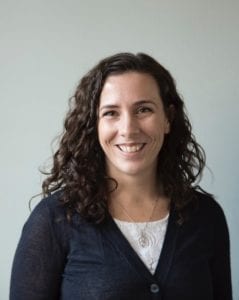Posted By: Sarah Ratzel, PhD, Science Editor, AJHG

Each month, the editors of The American Journal of Human Genetics interview an author of a recently published paper. This month, we check in with Alicia Martin (@genetisaur) to discuss her paper, “Population histories of the United States revealed through fine-scale migration and haplotype analysis”.
AJHG: What caused you to start working on this project?
Alicia: I started working on this project when a super talented MIT student, Cheng Dai (first author who has since graduated), came to me after a talk I gave at the Broad Institute. He and his colleagues had initiated a collaboration with National Geographic to understand the geographic patterns of genetic ancestry and admixture across the U.S., and Cheng had done substantial preliminary analyses and asked for mentorship in human population genetics. We started working together right away combining these genetic, geographic, and birth record data to understand fine-scale patterns of population history among diverse ancestral groups. Since the colonial era, the US population has been shaped by migration and admixture among groups from around the world. A multitude of factors have influenced these events, including the transatlantic slave trade, conflicts with Native Americans, segregation, and immigration policy. As a result, the US population is comprised of a large proportion of individuals with complex and admixed ancestry. Our goal of this study was to comprehensively characterize the extent to which the genetics of US individuals reflect demographic events.
AJHG: What about this paper most excites you?
Alicia: It was fascinating to uncover such a diverse set of populations using genetics and see how their fine-scale geospatial data reflect demographic history. For example, genetic patterns among African Americans across the US reflect historical practices of slavery and segregation, while differences among Hispanics/Latinos in ancestral birth countries and admixture proportions result in a variable genetic patterns across the country, especially among southwestern states and Florida. At the same time, it was exciting to resolve fine-scale Asian American origins. While they are the fastest growing demographic group in the US, they have largely been overlooked in population genetic studies of Americans. They have particularly diverse origins with population genetic structure separating groups of individuals with ancestors from within even the same country.

AJHG: Thinking about the bigger picture, what implications do you see from this work for the larger human genetics community?
Alicia: Historically, human genetics studies have largely focused on individuals of a single ancestry–primarily European ancestry. However, the population of the United States is extremely diverse and mixed. Our study highlights the diversity of the US population through varied continental and subcontinental origins. Understanding this population structure is important for the broader field of genetics, as it helps inform methods for identifying and accounting for stratification in association studies, prevent the overgeneralization of potentially confounded results, and avoid exacerbating existing Eurocentric study biases. Considering these biases with demographic trends that suggest more diversity and admixture into the future, genetics research must become more understanding and inclusive of diverse populations to deliver on its goal of improving healthcare for all.
AJHG: What advice do you have for trainees/young scientists?
Alicia: All science is social at some level, so having a set of supportive mentors is critical. In addition to choosing problems you find exciting and important, identify several key mentors who can together provide guidance on your science, communicate well with you, provide professional mentorship, build cohesive lab environments, and understand that circumstances beyond the lab influence your productivity in the lab.
AJHG: And for fun, tell us something about your life outside of the lab.
Alicia: My life outside of the lab is shaped by what feels like a transitional year–my fiancé and I are getting married this summer, we are both on the job market, and we expect to move at least houses (TBD on cities). With all of these impending changes, life outside of the lab is currently extremely varied and providing great excuses to reconnect with friends and family scattered across thousands of miles.
Alicia Martin, PhD, is an Instructor in Investigation at the Analytic & Translational Genetics Unit at Massachusetts General Hospital, an Instructor in Medicine at Harvard Medical School, and an Associated Scientist at the Broad Institute affiliated with the Stanley Center for Psychiatric Research and the Medical and Population Genetics Program.
